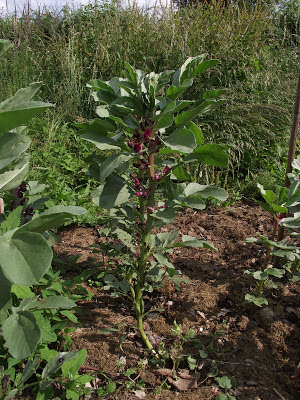My problem at the moment is that I've damaged my back somehow - I don't even know what I've done to it - an I can't do any work at all on the plot, which has become a complete jungle. It's embarassing. I force myself to go for a walk every day, often round the local reservoir, and get to the plot to pick beans and harvest seed. That's about all I'm fit for.
Hive 2 has superseded successfully. Four weeks ago,I found a single supercedure cell, as they raised a new queen. A week later, I opened the hive again, and found an act of regicide in progress. The cell had hatched, and the old queen, dead or dying, was in the middle of a mass of bees. Crawling over them and stinging repeatedly, was a fresh virgin. She's now mated and laying.
It wasn't a particularly strong swarm, and as a result it had
a brood break of a couple of weeks, during which eggs weren't being laid, and it wasn't building up. A
hungry bird could have eaten that queen on her mating flight or flights, or she
could have failed to mate in a spell of bad weather. In either case, of course,
the colony would have been doomed. Swarm survival in their first winter is
marginal in our climate, and anything which prevents numbers from building up
lessens its chances without beekeeper assistance. With our dodgy climate and
long winters, murdering the old queen as soon as the new one hatches is not a
survival characteristic.
It's easy to see why it's quite common for colonies to keep
the old queen going; it removes the brood break, and provides insurance. If the
first virgin fails, another can still be raised. This is why two-queen colonies
are found. I suspect it's a lot more common than we realise, but not many
people keep on looking for a queen after they've found the first one.
I've now harvested almost all my broad bean seed. I planted nine varieties, some of which had already crossed, and let them hybridise. I'll grow out the seed next year and see where I've got to. The aim is to produce a grex (variable variety) with red flowers and red, or 'black', seeds.
I planted five longpods; Aquadulce, Red Epicure, with red seeds, Dumont's (a Californian mix), Fava Lunga Della Cascine from Italy, and Karmazyn, another red seeded variety from Russia. None of them did particularly well, but the pods they did produce were full of beans. Red Epicure is now on the F3 generation. I've ben selecting for red seeds, and they don't look that different from the originals. The obvious difference is that the seeds are half the size of the originals. That could be down to soil or season, but I plant a lot of smaller seeded varieties, and they do better.
The Crimson Flowered Bean is an old one, aparently identical to the Red Blossomed Bean described in 1831, and probably older. It was originally very variable in colour, and Robinson's Seeds sell an apparently unselected strain. Real Seeds are working on a sport with chocolate coloured flowers. This may not be quite so surprising, given that there are 'black' (deep brown) beans. I have some in the freezer waiting to be grown out. It produces lot of small pods, with plenty of beans when it does well. This is the first time I've had any success with it.
Oldambster Wierboon, a Dutch variety, has pure white flowers. It grew well, but cropped very lightly.
Kaulion Valkea, from Finland, did well, as did Wizard, a very reliable variety from Real Seeds which crops a little later than the others. Both have masses of small pods and small beans.
I'm now trying Luz do Otono, a day length neutral longpod from Spain. in a mild autumn, it's supposed to prodice a November crop from a July sowing. It's not doing well at the moment. Whatever it does or doesn't manage, I'll add it to the mix next spring. Meanwhile, I've got little jars of bean seeds everywhere. That's one drawback of plant breeding; you have to save a lot more seed.
























